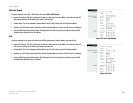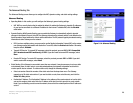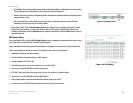
20
Chapter 5: Configuring the ADSL Gateway
The Setup Tab
ADSL Gateway
The Advanced Routing Tab
The Advanced Routing screen allows you to configure the NAT, dynamic routing, and static routing settings.
Advanced Routing
• Operating Mode. In this section, you will configure the Gateway’s general routing settings.
• NAT. NAT is a security feature that is enabled by default. It enables the Gateway to translate IP addresses
of your local area network to a different IP address for the Internet. To disable NAT, click the Disabled
radio button.
• Dynamic Routing. With Dynamic Routing you can enable the Gateway to automatically adjust to physical
changes in the network’s layout. Using RIP, the Gateway determines the network packets’ route based on the
fewest number of hops between the source and the destination. The RIP protocol regularly broadcasts routing
information to other Gateways on the network.
• RIP. If you have multiple routers, you may want to use the Routing Information Protocol (RIP) so the routers
can exchange routing information with each other. To use RIP, select the Enabled radio button. Otherwise,
keep the default, Disabled.
• Transmit RIP Version. To transmit RIP messages, select the protocol you want: RIP1, RIP1-Compatible
(RIP1 broadcasts and RIP2 multicasts), or RIP2. If you don’t want to transmit RIP messages, select
None.
• Receive RIP Version. To receive RIP messages, select the protocol you want: RIP1 or RIP2. If you don’t
want to receive RIP messages, select None.
• Static Routing. If the Gateway is connected to more than one network, it may be necessary to set up a static
route between them. A static route is a pre-determined pathway that network information must travel to
reach a specific host or network. To create a static route, change the following settings:
• Select set number. Select the number of the static route from the drop-down menu. The Gateway
supports up to 20 static route entries. If you need to delete a route, then select the entry and click the
Delete This Entry button.
• Destination IP Address. The Destination IP Address is the address of the remote network or host to which
you want to assign a static route. Enter the IP address of the host for which you wish to create a static
route. If you are building a route to an entire network, be sure that the network portion of the IP address is
set to 0.
F
i
g
u
r
e
5
-
1
4
:
A
d
v
a
n
c
e
d
R
o
u
t
i
n
g


















